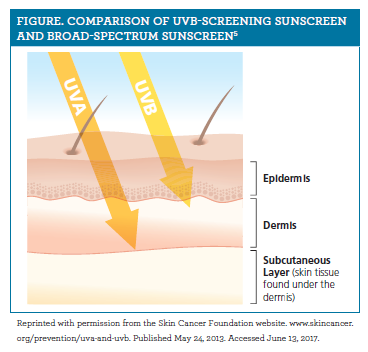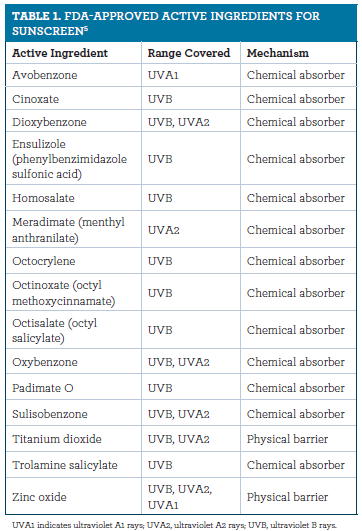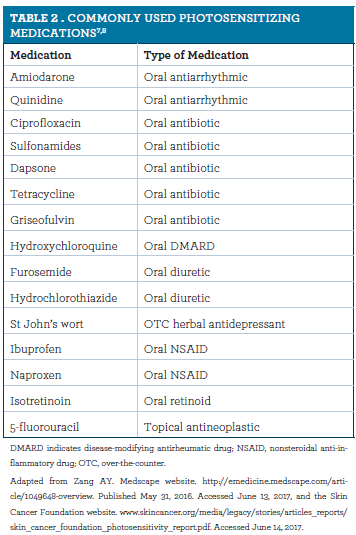Sunburn Prevention: A Review of Recommendations and Drug-Induced Photosensitivity
Summer is here, and so too is the increased focus on sunburn and skin cancer prevention.
Summer is here, and so too is the increased focus on sunburn and skin cancer prevention. Skin cancer is the most-diagnosed cancer in the United States, with an estimated 5 million cases diagnosed annually; as such, protecting your skin from the sun is critical in any season.1 Unprotected skin is subject to damage or sunburn in as little as 15 minutes when exposed to ultraviolet (UV) radiation from the sun, and over time this can result in melanoma or nonmelanoma skin cancer.2 While skin of any complexion is subject to damage, a number of risk factors predispose individuals to an increased risk of skin cancer.
SKIN CANCER RISK FACTORS3
- Heredity; family history of melanoma
- Fair-skinned individuals, usually with blonde or red hair and blue or hazel eyes
- People with many moles or large atypical moles
- Chronic lifetime sun exposure
- History of severe blistering sunburn
Of all the skin cancers diagnosed annually, under 2% (an estimated 87,110) will be melanoma; the rest will be nonmelanoma.1 Since 90% of nonmelanoma skin cancer cases are the result of UV radiation damage, pharmacists have a great opportunity to make a difference in their patients’ health.3 This article will detail recommendations for skin protection, review the many sunscreen options available on your shelves, and briefly highlight medications that predispose patients to UV radiation-induced skin damage.
RECOMMENDATIONS FOR SKIN PROTECTION
While not complex, methods for the prevention of sunburn and skin damage are highly effective. The CDC recommends the following:4
- Stay in the shade, especially during peak hours of 10 am to 4 pm.
- Wear clothing that covers your arms and legs.
- Use a hat that shades your face, head, ears, and neck.
- Wear sunglasses that block both ultraviolet A (UVA) and ultraviolet B (UVB) rays.
- Properly use a broad-spectrum sunscreen with a sun protection factor (SPF) of 15 or higher.
- Avoid tanning beds.
It is not reasonable to expect most of the population to adhere to the majority of the recommendations above. As a result, the proper use of sunscreen becomes critical for proper skin protection.

For a pharmacist, stepping out into the aisle to recommend an appropriate sunscreen can be daunting. The sheer number of products to choose from can put even the most informed pharmacist into a head-scratching state.

The CDC recommends products with broad-spectrum coverage along with minimum SPF requirements. Broad-spectrum coverage refers to sunscreen that protects against both UVA and UVB rays.4 These ultraviolet rays vary in wavelength and many active ingredients do not protect against both kinds. UVA is lower-intensity than UVB, but it penetrates the skin more deeply (figure5).5 It is important to note that UVA rays easily cut through water, clouds, and glass, while maintaining relative constant intensity throughout the year.4,5
UVB rays are more intense and will more rapidly cause sunburn. Their presence is more apparent at peak times during the day and during the spring and summer months, but the rays can still cause damage year-round. UVB rays will not penetrate glass but, like UVA, will cause damage through water.5 Some customers will make the mistake of selecting the product with the highest SPF without regard for the spectrum of coverage. This can be a costly error and presents pharmacists with an excellent opportunity to provide much-needed counseling. With that said, most manufacturers have shifted to broad-spectrum-only product lines, and the concern about buying the wrong spectrum coverage has declined as a result.
SPF is another important aspect of sunscreen selection. The SPF rating is an indicator of a product’s effectiveness in protecting against UVB radiation.5 This is key: SPF ratings do not translate to UVA coverage and will often mislead prospective customers.
The recommendation for use of SPF 15 or greater sunscreen is appropriate for everyday use, but increased protection, SPF 30 or greater, is recommended for extended periods of exposure to direct sunlight.5 Higher SPF ratings do indicate extended protection, yet the amount of added protection is not linear. In other words, an SPF 30 product does not provide twice the effectiveness of an SPF 15 product. The improved protection is beneficial, but efficacy experiences significant diminishing returns. Many clinicians question the value of going beyond SPF 50 due to the increased cost and minimal added benefit.3
There are several additional considerations when selecting a sunscreen. Niche products, such as water-resistant sunscreens or those marketed towards children or people with sensitive skin, are appropriate for customers with specific needs. They should meet the same efficacy criteria as other sunscreens. Sunscreen is not recommended for infants less than 6 months old; parents and caretakers should ensure that small children avoid sun exposure during peak hours and make use of clothing and hats to cover exposed skin when outside.2 The active ingredients in sunscreen provide protection by either chemical absorption or physical protection.5 These mechanisms are very different, but both are highly effective when sunscreen is applied correctly. For customers with sensitive skin, physical barriers are typically the preferred choice. Some of the more commonly used FDA-approved active ingredients are listed in table 15.5

PROPER SUNSCREEN APPLICATION
Traditional sunscreen lotions have several guidelines to follow for proper application. The American Academy of Dermatology recommends the following:6
- Sunscreen should be applied at least 15 minutes prior to sun exposure for full protection.
- Apply liberally to all bare skin; the average adult requires 1 ounce to cover all areas of exposed skin.
- Reapply sunscreen every 2 hours or immediately after swimming or excessive perspiring.
Additional considerations exist for the wide variety of sunscreen options in the marketplace. Products labeled as perspiration- and water-resistant—“sport” sunscreens—may make users think reapplication is unnecessary after exposure to water or heavy physical activity. However, these products are rated for no longer than 80-minute effectiveness in these environments; immediate reapplication is a must for optimal protection.3
Also, sunscreen sprays have gained significant popularity over the last few years due to perceived ease of application. Proper use of sprays includes rubbing the product into the skin during the application process, but this direction is often overlooked and sunburn is the result. Additionally, sprays make it difficult for users to gauge the amount of product applied. Lotions are a better first choice, but in the end, the most effective product is the one the customer will actually apply prior to going outside.
PHOTOSENSITIVE DRUGS
Many commonly used medications can predispose your patients to skin damage, sunburn, or dermatitis when used concurrently with sun exposure. Drug-induced photosensitivity reactions can occur in as little as 30 minutes, or symptoms of sun exposure may be delayed as long as 3 days. Immediate reactions are far more common and are considered phototoxic. These reactions generally resemble severe sunburn and are localized to sun-exposed areas of the skin.7
Photoallergic reactions are the result of an immune response and are far less common than phototoxic reactions. Onset can be delayed by 1 to 3 days; in severe cases, reactions may extend beyond the localized areas of previously exposed skin.7
Prevention is the best approach to handling photosensitivies. The CDC skin protection recommendations become all the more important when taking a photosensitive medication. Table 27,8 lists some of the more commonly used photosensitive medications. A complete list can be found in the Skin Cancer Foundation Photosensitivity Report.8
MAKING A DIFFERENCE
Proper skin protection is the only way to prevent the negative long-term effects of the sun’s UV rays. The prevention recommendations detail a number of easy-to-follow self-care guidelines that are often overlooked or misunderstood by prospective consumers. Community pharmacists possess not only the knowledge but also the access to customers in need; counseling in the aisles or at point-of-sale is a great way to improve outcomes and build customer loyalty.
REFERENCES
1. Cancer facts and figures 2017. American Cancer Society website. www. cancer.org/content/dam/cancer-org/research/cancer-facts-and-statistics/annualcancer- facts-and-figures/2017/cancer-facts-and-figures-2017.pdf. Accessed June 13, 2017.
2. How can I protect my children from the sun? Centers for Disease Control and Prevention website. www.cdc.gov/cancer/skin/basic_info/children.htm. Published April 27, 2017. Accessed June 14, 2017.
3. Lim HW, Wang SQ. The Skin Cancer Foundation’s guide to sunscreens. Skin Cancer website. www.skincancer.org/prevention/sun-protection/sunscreen/theskin- cancer-foundations-guide-to-sunscreens. Published 2012. Accessed June 13, 2017.
4. What can I do to reduce my risk of skin cancer? Centers for Disease Control and Prevention website. www.cdc.gov/cancer/skin/basic_info/prevention.htm. Updated June 13, 2017. Accessed June 13, 2017.
5. UVA & UVB. Skin Cancer Foundation website. www.skincancer.org/prevention/ uva-and-uvb. Published May 24, 2013. Accessed June 13, 2017.
6. How to apply sunscreen. American Academy of Dermatology website. www. aad.org/public/spot-skin-cancer/learn-about-skin-cancer/prevent/how-to-applysunscreen. Accessed June 13, 2017.
7. Zang AY. Drug-induced photosensitivity. Medscape website. http://emedicine. medscape.com/article/1049648-overview. Updated May 31, 2016. Accessed June 13, 2017.
8. Sarnoff DS, Saini R, Handel A. Skin Cancer Foundation Photosensitivity Report. Skin Cancer Foundation website. www.skincancer.org/media/legacy/ stories/articles_reports/skin_cancer_foundation_photosensitivity_report.pdf. Accessed June 14, 2017.
Jeffrey Mondelli, RPh, PharmD, MBA, is the Pharmacy Division Manager for Wakefern Food Corp (ShopRite Pharmacy) in Jamesburg, New Jersey.

